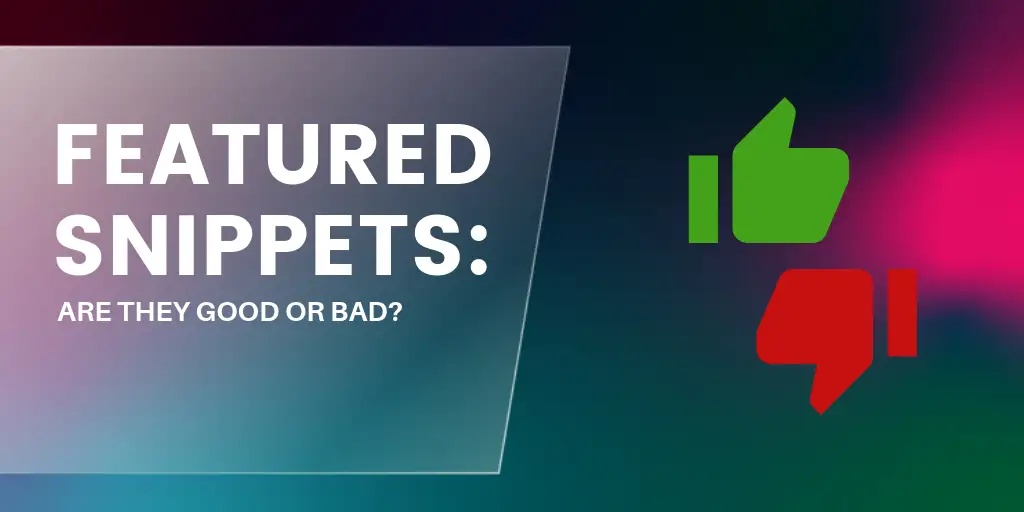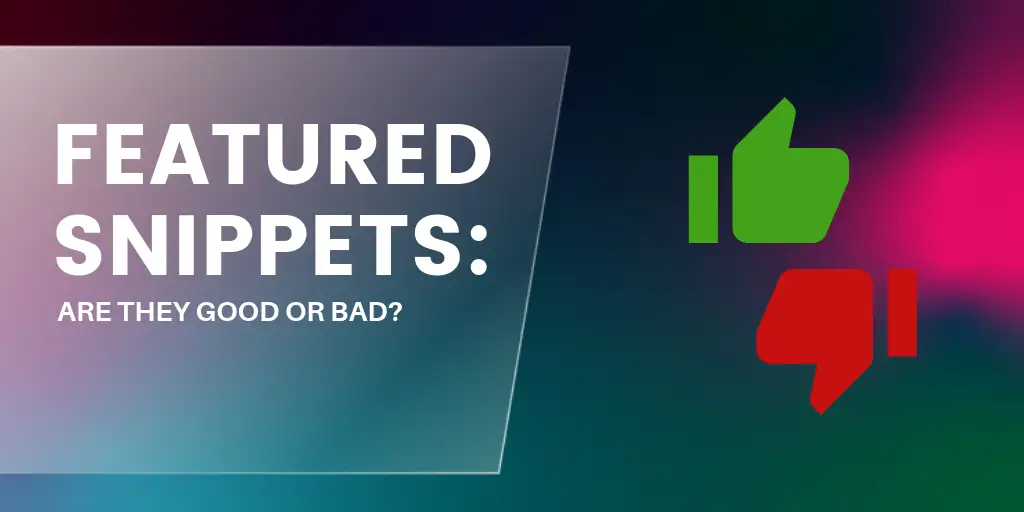

Featured Snippets: Good or Bad?
Are featured snippets a good or bad thing? That is the question.
Since the birth of content marketing and the implementation of rich SERP features by Google, being awarded with a featured snippet is often the equivalent of winning a medal at your school’s sports day – it’s big. But in this day and age, there is some deliberation over whether they still hold the same value today, and whether can they still be considered a “content win”.
In terms of value, featured snippets have always been known to improve brand awareness, increase traffic to your website and boost revenue. According to a 2017 study by Ahrefs:
- A featured snippet in the number 1 position gets 8.6% of clicks (on average), whereas the page that ranks right below it will get 19.6% of clicks (on average).
- If there is a regular number 1 ranking page with no featured snippet above it, that page will get 26% of all clicks.
Therefore the study shows that the featured snippet in position "zero" is stealing clicks from the number 1 ranking result.

This is good - just what us content marketers have been led to believe. However, today there is some worry that featured snippets are actually hurting clicks and traffic for websites across the SERP.
This belief, in short, is due to the evolution of the SERP, which has been accused of stealing traffic away from hard-working content marketers around the world. It is true to say that featured snippets have evolved into less clickable entities over the years, due to the changing format of snippets. These changes make it easier for any user queries to be answered in a featured snippet resulting in zero clicks on the SERP, and hence highlighting how earning a snippet may not be as important in the future.
Today, there are three main formats of featured snippets:
1. Featured snippets as direct answers
2. Featured snippets with supplementary content
1. Featured snippets as direct answers
Recently, it seems that the featured snippet has merged with a direct answer. Although featured snippets may not look like a direct answer, but in function they can be. If the prime user doesn’t need to click onto anything to get the information they need from the search, it is a featured snippet and direct answer merged together.
This means if you are hoping to gain a featured snippet to win traffic, you will be highly unlikely to achieve this simply because queries are being answered immediately on the SERP. As a result, it is unlikely for a user to click through to a website because the searcher will be satisfied with the response to their query in the featured box.
Once users have read the answer to their query, it is highly unlikely that users will continue to look for the answer by clicking onto the featured snippet, or indeed any other URLs on the SERP. This is a modern flaw of the featured snippet.
2. Featured snippets with supplementary content
Another modern featured snippet from Google is a featured snippet which shows other supplementary content alongside the box, often next to a ‘knowledge panel’ or an ‘explore panel’ - sometimes both depending on the searcher intent. By placing additional content alongside the featured snippet, the need for any click is significantly diminished. Again, this is a modern flaw of the featured snippet.
3. Featured snippets as lists
Lists presented in either numbered or bullet point form are perhaps the most common form of featured snippet. Often, they are shown as a partial list, which can only be fully accessed with a click to the site. This is the form of snippet that content marketers constantly chase, however, this may change. This year, there has been some controversy over the discovery of a featured snippet that requires a tab to expand before a user can view the website's URL.
Consequently, this is making it difficult for a user to click onto the original source of information, and henceforth reducing the chance of click through rate on the SERP. Google is essentially not giving website's appropriate credit, which is entirely unfair. This is a clear example of the modernisation of the featured snippet being a serious issue for content marketers going forward.
So, do modern featured snippets reduce CTR?
 According to a recent study by Rand Fishkin (Spark Toro), undertaken with Jumpshot, there has been a significant increase in no-click searches. In fact, 49% of all Google searches are no-click. The report highlights that Google is indeed “siphoning” a large proportion away from websites, in favour of serving information or answers within a featured snippet, and making the source hard to find.
According to a recent study by Rand Fishkin (Spark Toro), undertaken with Jumpshot, there has been a significant increase in no-click searches. In fact, 49% of all Google searches are no-click. The report highlights that Google is indeed “siphoning” a large proportion away from websites, in favour of serving information or answers within a featured snippet, and making the source hard to find.
This was found earlier this year when Cyrus Shepard posted a screenshot of a featured snippet answering the search query "seeds with highest omega 3", which pulled data from a number of different websites with no obvious clickable credit to the original sources. (Pictured)
Due to the three modern featured snippet types answering each searcher’s query instantaneously on the SERP, it begs the question that every content marketer has on their lips: why is there any need to click through to the source?
This is highlighted by research that shows 38% of desktop users do not click on results in the SERP because they found an answer to their query in a featured snippet, and this number rises to 57% on mobile.
According to Cyrus Shepard, "This is the future of Google Search" and may be something we need to get used to. Content marketers in the near future may wish to tweak their content marketing strategies in order to fit around the ever-changing and modernisation of the Google SERP.
Rand Fishkin also responded: "As this becomes the future, an interesting thing happens... the value of creating useful, accurate content for the web diminishes, [because] while publishers do the work, Google alone gets all the benefits. Their trojan horsing of the web is subtle, but damned effective."
This poses the million dollar question: Are featured snippets worth chasing anymore?
Even though the information given to the user may be useful and hold the website in high regard, these modern featured snippets can hinder the traffic coming to the site - which is the main aim. These significant changes are no doubt causing worry for content marketers and website owners around the world, who once believed achieving a featured snippet was a major achievement.
However, it’s not all bad. Even though modern featured snippets make it less likely for users to click onto any results on the SERP, gaining a snippet can still help you to earn credibility points. Users looking at an answer in a featured snippet will be drawn to the answer in the featured snippet, because it often directly answers their question, and will see the source as someone with high authority in the field relating to the question. That's good, right? So, even though a user may not click onto your website at that moment, there is a chance that your website will be remembered and used at a separate time to answer a separate query.
However, bloggers and content marketers will be pleased to know that featured snippets will be changing in the near future, thanks to the introduction of three brand-new meta tags from Google to add into your website's code. Thus, it is becoming easier for webmaster's to control featured snippets from page-to-page, if it gets awarded with the prestigious "position zero". Read our blog post on how to use Google's new meta tags to control your site's snippet for more information.
What do YOU think?
We ran a poll on our Twitter account and found that users overwhelmingly believe that featured snippets are good.
Good morning Twitter, and Happy #HumpDay! Today we want to know: do you think featured snippets are a GOOD or BAD thing?
It'd be great to hear why you think the way you do too!
— Reboot Online (@rebootonline) September 4, 2019
